Tiny Bedside Lamps: Functionality Meets Style
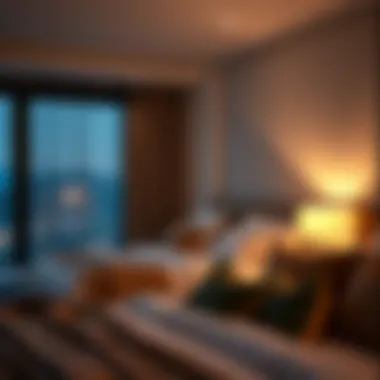
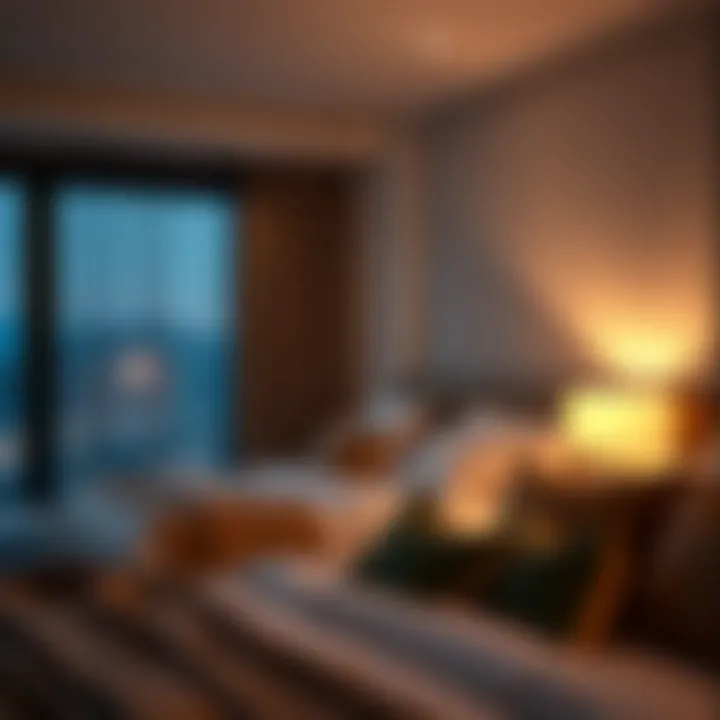
Intro
When it comes to designing a bedroom, every detail counts. Tiny bedside lamps might seem like a small player in the grand scheme of decor, but their role is significant. These fixtures are not only functional for late-night reading or creating a cozy atmosphere; they also contribute to the overall aesthetic appeal of a space. A well-chosen lamp can tie together various elements of interior design, influencing mood, style, and even the room's perception of size. In this exploration, we will uncover the functionality and aesthetics of tiny bedside lamps, delving into current design trends, practical tips, and how to make meaningful selections based on individual preferences.
Furniture Design Trends
As we navigate through the modern world of interior design, certain trends emerge that highlight the role of tiny bedside lamps. Design is no longer just about practicality; it’s also an expression of personality and lifestyle.
Current Styles and Themes
Tiny bedside lamps come in a range of styles, each catering to different tastes. From Scandinavian minimalism to bohemian chic, the options are vast. Here’s a closer look at some prominent themes:
- Mid-Century Modern: Clean lines and organic shapes define this style, featuring lamps with wood bases and fabric shades.
- Industrial: Exposed bulbs and metals like brass or steel give a raw, edgy touch, perfect for a loft-style bedroom.
- Bohemian: Mismatched patterns, textures, and vibrant colors create an inviting atmosphere; look for lamps with woven designs or intricate details.
- Contemporary: Focused on sleek designs and innovative materials, these lamps often incorporate LED technology, emphasizing efficiency.
Each theme presents a variety of shapes, allowing homeowners and designers to find lamps that resonate with their vision.
Color Palettes and Materials
The choice of colors and materials can dramatically affect the look of a bedside lamp. When selecting a lamp, consider how the palette harmonizes with your existing decor.
- Neutral Tones: Shades of white, gray, and beige often lend a calming effect, making them perfect for serene spaces.
- Bold Colors: Lamps in deep greens, yellows, or blues can serve as focal points, drawing the eye and adding a splash of character.
- Materials: Choices range from ceramic, glass, and metal to sustainable options like bamboo or recycled materials. Each material has its own unique texture that can complement or contrast with bedroom furnishings.
"A bedside lamp isn’t just a source of light; it’s a beacon of style that reflects who you are in your personal space."
Practical Furniture Tips
Selecting the right tiny bedside lamp involves thoughtful consideration beyond just aesthetics. Here are some practical tips to ensure optimal choice and placement in your bedroom.
How to Choose the Right Size
Finding the right size lamp is crucial. If it’s too tall, it may overshadow other elements in the room; too short, and it may underwhelm. Consider the following:
- Height: A good rule of thumb is that the bottom of the lampshade should be at eye level when you’re sitting up in bed.
- Base Size: Ensure the base of the lamp isn’t overly large or small in proportion to your bedside table, allowing for balance and functionality.
Maintenance and Care for Longevity
Once you’ve chosen the perfect lamp, maintaining it is key to preserving its beauty and function. Here are a few simple steps:
- Dust Regularly: Accumulated dust can dull finishes and reduce brightness. A soft cloth should be used weekly to keep it sparkly.
- Check Bulbs: Consider energy-efficient LED bulbs that not only consume less energy but also last longer. Regularly check and replace as needed.
- Handle with Care: When cleaning or relocating, always lift the lamp by the base rather than the shade to prevent damage.
This comprehensive examination enables homeowners and designers alike to appreciate how tiny bedside lamps can enhance both functionality and style in any bedroom.
For more insights into design trends and practical tips, check sources at
Wikipedia on Interior Design
Britannica on Furniture Style
Reddit's Home Decor Community
Facebook Groups about DIY
Intro to Tiny Bedside Lamps
In our modern homes, every piece of decor holds significance, but few items carry as nuanced a value as tiny bedside lamps. These compact fixtures are about more than just providing light; they are integral to crafting a specific ambiance and enhancing the overall aesthetic of a bedroom. Think of them as the gentle guardians of our nighttime routines, serving both functional and decorative purposes.
One of the primary benefits of tiny bedside lamps is their ability to fit seamlessly into various spaces without overwhelming the room. Their small size allows for creative placement options, whether sitting on a nightstand or perched on a shelf. This versatility extends to style as well—tiny lamps come in a vast array of designs, materials, and colors, making it easy to find one that aligns with individual tastes.
Additionally, the right lamp can facilitate a broad spectrum of activities, such as reading a gripping novel before bed or illuminating a workspace for late-night journaling. By providing adequate lighting tailored to different tasks, these lamps contribute significantly to the functionality of a bedroom.
When considering a tiny bedside lamp, it’s essential to think beyond mere wattage and brightness levels. The lamp's design, material, height, and compatibility with smart home systems also play a vital role in shaping the overall aesthetic and utility of the space.
"Choosing the right bedside lamp is akin to selecting the perfect wine to pair with your meal—each has its unique flavor and impact on the experience."
In summarizing the importance of tiny bedside lamps, it becomes evident that their presence is not just about avoiding the dark. They can elevate the decor, enhance functionality, and contribute to a cozy atmosphere that promotes relaxation. As we embark on this exploration of their functionality and aesthetics, we will delve deeper into how these small yet impactful items can transform our evenings and improve our well-being.
The Importance of Lighting in Home Design
Lighting plays a pivotal role in any home, influencing not just visibility but also the overall ambiance of a space. When it comes to tiny bedside lamps, their functionality extends beyond mere illumination; they enhance the design aesthetic and foster a sense of comfort. Homeowners must grasp the significance of lighting to create spaces that reflect their personality and meet practical needs.
Understanding Light Layers
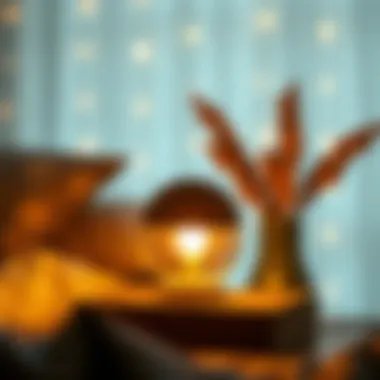
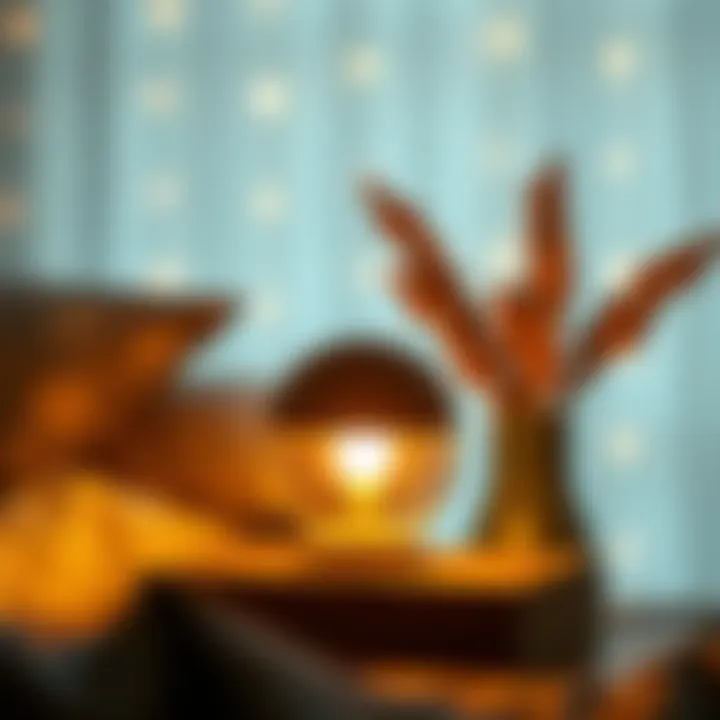
To truly appreciate the importance of lighting, consider the concept of light layers. Just as a painter uses various colors and techniques, interior designers and homeowners can layer light to achieve depth and functionality. The three primary layers include ambient, task, and accent lighting.
- Ambient lighting provides the general illumination needed for daily activities. It’s the backbone of your light design, usually coming from overhead fixtures or natural light penetration.
- Task lighting focuses on specific areas where activities such as reading or working occur. Tiny bedside lamps are perfect examples, as they provide just the right amount of light for nighttime reading without flooding the entire room.
- Accent lighting highlights particular features, like artwork or architectural details. While tiny lamps may not be used primarily for this purpose, they can serve an accentual role when placed strategically.
Each layer has its own importance and must be considered in tandem to achieve a harmonious ambiance. The effectiveness of lighting can significantly impact mood, productivity, and even safety within the home.
Mood and Atmosphere
The atmosphere of a room can shift dramatically based on its lighting. Consider how soft, warm light can create a serene environment, making it ideal for bedrooms where relaxation is paramount. In contrast, cold, harsh light can provoke stress and anxiety, making it less suitable for areas designated for winding down.
Tiny bedside lamps can contribute tremendously to the mood by offering customizable light levels. A simple dimmer switch can set the tone for various activities, be it preparing for bedtime or enjoying a late-night novel. Furthermore, the decorative aspect of these lamps allows homeowners to express their style—be it bold, contemporary, or vintage.
"Lighting is like the thread that stitches together all the design elements in a room, both practical and aesthetic.'
By thoughtfully integrating various types of lighting, individuals can not only enhance the aesthetics of their homes but also positively influence their well-being. When examining the ligthing choices for your space, it’s crucial to remember that each element—from the type of bulb to the design of the lamp—plays a part in the emotional resonance of the environment.
In summary, understanding the layers of light and how they contribute to mood positions tiny bedside lamps as essential components of home design. Attention to lighting is not only about functionality; it's about creating a sanctuary that invites peace, creativity, and comfort.
Size Matters: The Case for Compact Design
In the realm of bedroom aesthetics and functionality, size indeed plays a pivotal role. Compact bedside lamps fit seamlessly into limited spaces while still providing essential lighting. Their design often harmonizes with various decor styles, making small spaces feel more accommodating. There’s the often overlooked charm of a well-placed tiny lamp; it beckons warmth yet doesn’t overwhelm the eye.
Proportionality in Interior Spaces
When considering proportionality, think about how the size of an item aligns with the surrounding space. A petite lamp, when paired with a smaller nightstand or a cozy nook, can make a room breathe. An oversized lamp, on the other hand, can create an imbalance, causing the area to feel cramped or cluttered. The idea here is to cultivate harmony within the space. This alignment boosts not only visual appeal but also functional efficiency. Smaller lamps can serve multiple purposes—providing atmosphere, aiding nighttime reading, and reducing glare. Their minimal footprint often makes them less of a design distraction, allowing other elements to shine.
For instance, when you pop a compact lamp on an end table beside a minimalist bed frame, you're not just saving space; you're also accentuating the beauty of your design choices. Simplifying your lamp selection to fit the available area ensures every inch is used wisely.
Utilizing Vertical Space
While the horizontal space often gets more attention in design discussions, vertical space is just as critical, especially in smaller bedrooms. Compact bedside lamps often extend upward rather than outward. The base of these lamps can occupy a small section of the nightstand, while the light fixture reaches towards the ceiling, illuminating more of the room without requiring extensive horizontal space.
Selecting a lamp design that draws the eye up can create an illusion of height, making a low ceiling seem higher. Shelving, wall-mounted fixtures, and tall lamps can enhance this effect. For example, a slender floor lamp might serve as the perfect alternative to a bulky nightstand lamp, drawing the gaze upward and maintaining an open feel in the room.
Utilizing multiple levels for lighting also encourages a layered approach to illumination. You can mix and match your tiny lamps with wall sconces or ceiling mounts, creating a varied lighting strategy that enhances general ambiance and usability.
When you harmonize your lighting choices with the space available, every corner of your room can become a purposeful area.
In summary, the compactness of bedside lamps goes beyond mere inches; it significantly influences the aesthetics and functionality of your bedroom. By carefully considering proportionality and how you can use vertical space, you can curate a serene environment that remains stylish and functional.
Material Considerations
The choice of materials in bedside lamps not only impacts their longevity but also plays a crucial role in defining their aesthetic appeal. Homeowners and designers alike understand that materials can influence the overall vibe of a room. Selecting the right material is not merely an afterthought but an essential part of the design process.
When diving into the specifics, there's a variety of materials that can be found in bedside lamps. Each brings its own unique characteristics and advantages. A material's weight affects stability, while its surface texture can enhance or detract from the visual experience of a space. Understanding these factors can elevate the way a bedside lamp integrates into your bedroom decor.
Common Materials Used in Bedside Lamps
In the realm of lamp materials, one often encounters a mixed bag, but some stand out for their prevalent use:
- Metal: Commonly found in the form of brass or steel, metal lamps offer sleek designs and durability. Their reflective surfaces can create interesting light patterns and enhance the ambiance of a room.
- Glass: Often used in shades or bases, glass lamps provide a touch of elegance. Frosted or clear finishes can soften the appearance of light, making it warmer and inviting.
- Ceramic: Known for its versatility, ceramic can be shaped into numerous styles. It allows for intricate designs and can be painted or glazed in various colors to match one’s decor.
- Wood: This offers a natural and warm aesthetic. Wooden lamps can range from rustic to modern, depending on their finish and design. The organic feel of wood can bring an element of nature indoors.
These materials each bring something unique to the table. For instance, metal lends a contemporary edge, while wood can generate coziness— households often seek a balance between form and function that these materials provide.
Sustainability in Material Choices
Thus, the question of material sustainability emerges as a pressing concern in today’s eco-conscious society. As designers and homeowners opt increasingly for energy-efficient and environmentally friendly products, the materials used in bedside lamps cannot be overlooked. Choosing sustainable materials involves scrutinizing the lifecycle of the products, from sourcing to disposal.
- Recycled Materials: Utilizing recycled metals or glass can significantly reduce resource consumption and waste. This choice benefits both the environment and the aesthetics of the lamp; many find offbeat designs appealing.
- Bamboo or Cork: These materials are renewable and biodegradable. Bamboo grows rapidly, and cork harvesting doesn't harm the trees, making them excellent choices for environmentally conscious options.
- Low-VOC Finishes: When considering painted or varnished lamps, it’s vital to choose options that release minimal volatile organic compounds. This ensures better indoor air quality and supports a healthier living space.
In the quest for sustainability, knowing where your materials come from is paramount. Designers are now tasked with not just selecting materials but also advocating for responsible sourcing. The lamps one chooses reflect values beyond mere aesthetics; they embody a commitment to sustainability that resonates with contemporary lifestyles.
"Green design isn't a trend; it's a movement toward a sustainable future, and lighting plays a pivotal role in this evolution."
As the conversation around materials evolves, it fosters a greater awareness about choices in design. Thoughtful material selection is not only a mark of good taste but also an expression of ethical considerations, achieving harmony between decorative illumination and environmental responsibility.


Design Aesthetics
When it comes to the realm of interior design, aesthetics play a vital role, especially in personal spaces like bedrooms. Tiny bedside lamps contribute not just illumination, but they also serve as integral design elements that tie the decor together. The selection of a lamp goes beyond functionality; it’s about making a statement that resonates with the overall design language of a room. From vintage charm to sleek modernism, the right lamp can express individuality while enhancing the visual appeal of the space.
In incorporating aesthetic considerations, homeowners, designers, and decorators must evaluate the lamp's shape, texture, and finish alongside the room’s overarching theme. Whether aiming for a minimalist feel or a cozy, eclectic vibe, these aspects can either harmonize beautifully or clash dissonantly with the surrounding furnishings.
One could argue that the primary benefit of choosing well-designed lamps lies in their ability to create focal points within a room. A striking lamp can become a talking piece; it can draw the eye, dictate mood, and even inspire the layout of other elements. Moreover, small lamps often stand as reflections of those who inhabit the space, each choice revealing something about personal taste and lifestyle.
Styles and Trends
The variety of styles available when selecting tiny bedside lamps is staggering. Picture a contemporary bedroom where sleek, geometric lines dominate the decor. In such cases, lamps with clean silhouettes, perhaps in brushed metal or matte finishes, can enhance the room's modern ethos. On the other hand, a Bohemian-infused bedroom might benefit from hand-painted ceramic lamps or those adorned with colorful fabric shades that radiate warmth and creativity.
Emerging trends in the realm of lamp design now frequently focus on sustainability. Many modern tiny lamps are crafted from recycled materials or feature energy-efficient technologies. This trend not only appeals aesthetically but also aligns with a growing consciousness among consumers about their environmental footprint. A lamp that is both stylish and eco-friendly? That’s a win-win situation.
Key Styles to Consider:
- Scandinavian Minimalism: Characterized by functionality and simplicity, with soft hues and natural elements.
- Industrial Chic: Incorporating raw materials like metal and wood, perfect for adding a rugged touch.
- Vintage Flair: Often features ornate designs, evoking nostalgia and warmth.
- Modern Avant-Garde: Unconventional shapes and innovative materials that push the boundaries of traditional decor.
Color Coordination with Bedroom Decor
When discussing design aesthetics, one mustn’t overlook the significance of color coordination. The color palette of a tiny bedside lamp should complement or contrast with the bedroom’s decor for a polished look. For instance, in a room painted in a calming teal, a warm light wood lamp can establish a delightful balance, adding warmth without overwhelming the existing color scheme.
In contrast, bold and vibrant hues can serve as lively accents. Imagine a monochromatic room punctuated by a bright red or vivid yellow lamp. This strategy works especially well with neutral walls, allowing that single pop of color to energize the space—like a burst of sunshine on a cloudy day.
Considerations for Color Coordination:
- Match or Contrast: Does the lamp need to blend in with the existing colors, or should it stand out?
- Tone and Shade: A lamp’s shade can significantly alter its color perception; a warm-toned lamp will radiate a different feel than a cool-toned one.
- Texture and Finish: The finish on the lamp—be it matte, glossy, or textured—can also influence how its color interacts with the room's hues.
In summary, the aesthetics surrounding tiny bedside lamps extend beyond mere style; they encapsulate the spirit and essence of a space. Therefore, choosing a lamp requires thoughtful consideration, not just about what looks good but how it works within the context of the entire room.
Functionality Features
When it comes to tiny bedside lamps, functionality is just as crucial as aesthetics. These small light sources are not merely for decoration; they serve various practical purposes that enhance the overall experience in the bedroom. From providing the right amount of light for late-night reading to acting as a modern gadget, understanding these functionality features can guide homeowners and designers in making informed choices.
Adjustable Brightness Options
One of the standout features of many modern tiny bedside lamps is their adjustable brightness. This option allows users to change the intensity of the light, catering to different activities throughout the day and night. For instance, a soft glow is perfect for winding down before sleep, whereas a brighter setting may be beneficial during night time readings or getting ready in the morning.
- Benefits of Adjustable Brightness:
- It accommodates different moods and tasks, enhancing versatility.
- Reduces eye strain by providing suitable lighting based on activity.
- Conservation of energy; lower brightness can save energy while still offering functionality.
Adding this feature can significantly influence the lamp's effectiveness in contributing to the atmosphere of the bedroom. By selecting a lamp with adjustable brightness, homeowners have greater control over their environment, ensuring it suits their needs at any moment.
Smart Technology Integration
The rise of smart home technology has also seeped into the realm of bedside lamps. Smart technology integration is a remarkable functionality feature that elevates the usage of these lamps, making them adaptable to contemporary living. Through app controls, voice assistants like Amazon's Alexa or Google Assistant, and programmable settings, users can manage their lamps with ease.
- Advantages of Smart Integration:
- Remote operation allows the lamp to be turned on or off from a distance, a great convenience.
- Programmable timers can help automate lighting based on sleep schedules or daily routines.
- Integration with other smart home devices can enhance the overall experience, such as syncing with sound systems for ambient lighting during movie nights.
"Smart technology has turned ordinary lamps into multifunctional hubs that can help simplify daily lives, especially in the bedroom where comfort meets technology."
Incorporating these intuitive features makes tiny bedside lamps more than mere light sources; they become integral components of the home environment, improving quality of life.
By emphasizing adjustable brightness and smart technology, tiny bedside lamps exemplify a blend of functionality and aesthetics. These features not only contribute to the practical use of the lamp but also enhance overall decor, making the space not just visually appealing but also supremely functional.
Choosing the Right Lamp for Your Space
Choosing the right lamp for your space is more than just a practical decision; it significantly impacts the overall vibe and functionality of your bedroom. The right bedside lamp does not only light up the area but also enhances the aesthetic appeal, contributing to the overall atmosphere you are trying to create. When picking the perfect lamp, there are several factors to consider, such as height, base, and placement to ensure you strike the right balance between style and utility.
This section delves into the intricate details needed to make an informed choice when it comes to lamps that suit your personal space, aiming to educate not just homeowners, but also interior decorators and DIY enthusiasts. A well-chosen lamp can act as an extension of your personality, transforming a simple bedside table into a stylish focal point that combines form and function.
Height and Base Considerations

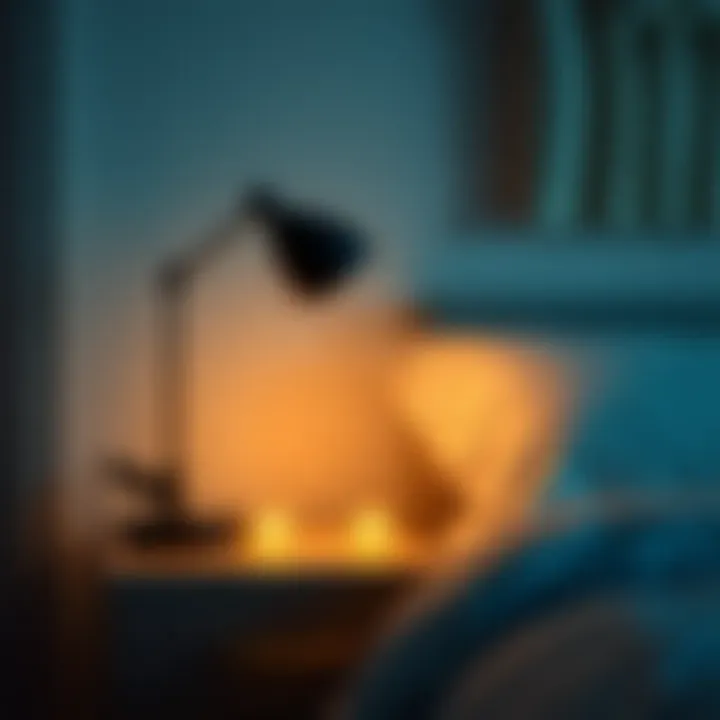
When selecting a lamp for your bedside, height is a crucial aspect that should not be overlooked. Ideally, the lamp should be at a height that allows for easy access to its controls without the need to stretch or lean uncomfortably. A good general guideline is that the bottom of the lampshade should be about 24 to 28 inches above the mattress. This ensures that the light is directed toward your reading material rather than your eyes, avoiding glare which can be irritating during late-night reads.
Another element to consider is the base of the lamp. The base not only anchors the lamp physically but also visually within the room's aesthetics. A heavier base often provides stability, essential if you have pets or restless sleepers near the bedside. For narrow tabletops, you might want to opt for a narrower base style, providing balance without overwhelming the space. The materials used for the base—be it ceramic, metal, or wood—can also add depth to your design. These factors combined play an important role in complementing your existing decor.
Best Placement Strategies
Placement may seem straightforward, but it often requires strategic thinking to achieve the best layout. First, evaluate your bedside table and assess the space you have available. Ideally, the lamp should sit on a flat, stable surface, but consider the surrounding decor too. Placing a lamp too far back on the table may not optimize its utility, while positioning it too close to the edge could lead to accidents.
One effective strategy is to place your lamp on the side of the table that's closest to you. This keeps everything within arm's reach, including your books, phone, or a glass of water. Additionally, consider the room's layout. If your room features a symmetrical design, aligning the lamp with other elements can create visual harmony.
Using multiple small lamps on larger tables rather than a single, large one can also offer a layer of coziness, especially when you pair them with similar materials or colors from your decor.
Emphasizing the importance of size and placement, even a small lamp can make a significant difference in how you perceive and utilize your space.
Overall, choosing the right lamp transforms more than just lighting; it's about creating an environment conducive to relaxation and well-being. By paying attention to height, base, and placement, you position yourself for success in crafting a cohesive and stylish bedroom setup.
The Role of Tiny Bedside Lamps in Personal Well-Being
Tiny bedside lamps play a pivotal role in enhancing personal well-being, acting as both functional tools and aesthetic elements that contribute to the ambiance of a living space. Their presence can often be the difference between a cold, sterile bedroom and a warm, inviting retreat. This section looks into how these small fixtures impact various aspects of our daily lives, helping us cultivate wellness through thoughtful illumination.
Impact on Sleep Quality
Sleep is essential for overall health, and the right lighting can serve as a subtle yet powerful influence on our sleep quality. Tiny bedside lamps are particularly advantageous when it comes to setting the mood for a restful night's sleep.
A warm glow emitted by lamps with soft light bulbs, like LED options that have a color temperature on the lower end of the spectrum, can signal to your body that it’s time to wind down. In contrast, stark, bright white lights often disrupt our circadian rhythms, making it harder to fall asleep.
Consider the bedside lamp as part of your pre-sleep routine.
- Soft, Adjustable Brightness: If you have a lamp that offers dimming features, you can easily adjust the light when it's time for bed while still having enough visibility to read or browse.
- Placement Matters: Positioning the lamp on a bedside table within reach ensures you can turn it off without getting out of bed, circumventing unnecessary disturbances in your nighttime routine.
"The right lighting helps signal your mind and body that it’s time to rest, much like a gradual sunset prepares the world for slumber."
Creating a Relaxation Zone
Beyond merely aiding sleep, tiny bedside lamps help define your personal relaxation zone. These lamps can transform your bedroom into a sanctuary where one can escape the day’s stress. Creating an environment conducive to relaxation involves several factors, where lighting holds significant sway.
- Strategic Lighting Layers: Utilizing lamps alongside other light sources in your bedroom allows you to create layers of light, providing a balance between bright and subdued lighting. For example, pairing a bedside lamp with soft overhead lights can create a balanced, serene environment.
- Color Temperature Influence: Choosing lamps with warmer illumination can promote feelings of calm and comfort. Many people find that cooler light—akin to daylight—may be too stimulating for end-of-day relaxation. You might wish to experiment with different bulbs to find the one that resonates with you, fostering a personal haven.
- Design Features for Accent: The design and finish of a lamp can also contribute to your relaxation zone. A stylish ceramic lamp or a soft fabric shade can add a cozy touch that complements your bedroom’s decor, emphasizing comfort.
In essence, tiny bedside lamps not only serve practical functions but also shape the emotional and psychological aspects of your personal space. By integrating thoughtful lighting into your bedroom, you're investing in your well-being, one light bulb at a time.
Energy Efficiency and Eco-Friendliness
In today's world, the conversation around energy efficiency and eco-friendliness is more relevant than ever. This is particularly true when it comes to tiny bedside lamps, which might seem like small players in the grand scheme of home lighting but can actually make a significant impact on both the environment and your wallet. Choosing lamps that prioritize energy efficiency not only reduces your carbon footprint but also lowers electricity bills in the long run. Furthermore, integrating eco-friendly designs underscores a commitment to sustainability, appealing to a growing audience of conscientious consumers.
LED vs. Traditional Bulbs
When it comes to bedside lamps, the choice between LED and traditional incandescent bulbs is a no-brainer. LED bulbs have revolutionized lighting, offering durability and efficiency that incandescent bulbs cannot match.
- Energy Consumption: LEDs consume up to 75% less energy than traditional bulbs, making them a cost-effective option over time. This means if you leave your lamp on for long periods or use it as a common reading light, the savings can add up.
- Lifespan: An LED bulb can last anywhere from 15,000 to 50,000 hours, compared to a mere 1,000 hours for incandescent bulbs. Imagine the hassle and waste of frequently replacing bulbs!
- Heat Emission: LEDs emit less heat than their incandescent counterparts. This means they not only keep a room cooler but also reduce the risk of burns if touched. This is particularly relevant for tiny bedside lamps that are typically close to where you sleep.
- Light Quality: Many LED options provide a warm light comparable to traditional bulbs, ensuring you don’t sacrifice ambiance while being environmentally conscious. Overall, opting for an LED bulb in your bedside lamp is not just a smart choice; it’s a necessity in modern home design.
Long-term Cost Benefits
Choosing energy-efficient lighting like LED bulbs in tiny bedside lamps is about more than immediate savings. It’s a savvy investment that pays dividends over time.
- Lower Electricity Bills: Given their reduced energy consumption, the shift from traditional bulbs to LEDs can lead to noticeable savings on monthly energy bills. Many homeowners report reductions of several dollars a month, which translates into significant annual savings.
- Less Frequent Replacements: The extended lifespan of LEDs means fewer replacements. This saves you not just money on new bulbs but also the time and effort involved in changing them regularly.
- Increased Home Value: Sustainable choices often appeal to potential buyers. As awareness around energy efficiency grows, home buyers are more inclined to invest in properties that reflect a commitment to eco-friendliness.
- Tax Incentives: Depending on your location, there may be tax benefits or rebates available for switching to energy-efficient lighting options. It’s worth looking into local resources that may support this switch.
Choosing the right bedside lamp can lead to a harmonious balance between functionality, aesthetic value, and eco-consciousness. It is an investment not only into your immediate comfort but also into the well-being of the planet.
With these benefits in mind, it becomes clear that energy efficiency and eco-friendliness are not just trends in home design; they are essential elements of truly modern living. By making informed choices about the lighting in our personal spaces, we contribute to a more sustainable future while enhancing our comfort and style.
Ending
In this article, we've explored how tiny bedside lamps serve as both functional and aesthetic elements in modern bedrooms. Their compact design allows for flexibility in space usage, fitting perfectly into small corners and crevices without overwhelming the room. By incorporating a variety of materials and styles, these lamps cater to diverse tastes and interior themes, enhancing the overall ambiance of personal spaces.
Recap of Key Points
- Importance of Lighting: We've underscored that lighting goes beyond mere visibility; it's a crucial contributor to the mood and atmosphere of a room.
- Compact Design: Tiny lamps bring forth the idea that sometimes less is more, and smaller options can still pack a punch in terms of functionality and style.
- Material Choices: Sustainability is important in today's market, and the selected materials play an essential role in determining both the lamp's look and its environmental impact.
- Functionality Features: From adjustable brightness to smart technology integration, modern lamps offer features that cater to comfort and convenience.
- Placement Strategy: Correct positioning can enhance not just functionality, but also visual appeal, integrating the lamp seamlessly within the space.
- Energy Efficiency: The transition from traditional bulbs to LED options not only saves energy but can also significantly reduce long-term costs.
Final Thoughts on Tiny Bedside Lamps
As we navigate through design trends and the practicalities of home decor, tiny bedside lamps emerge as understated champions. They harmonize appearance with utility, marking their territory as essential elements in bedroom aesthetics. Their role isn't just about lighting; they also contribute to a relaxed environment, reinforcing the notion that thoughtful design can alter our daily experiences. Whether one is an interior decorator, a homeowner sprucing up their space, or a DIY enthusiast looking for the ideal fixture, tiny bedside lamps are not just lamps—they are a statement of intent in your personal sanctuary.
"It's not just about light; it's about life and how we illuminate our moments."
Ultimately, the right tiny bedside lamp can be the finishing touch that brings warmth, personality, and thoughtfulness into any bedroom.



